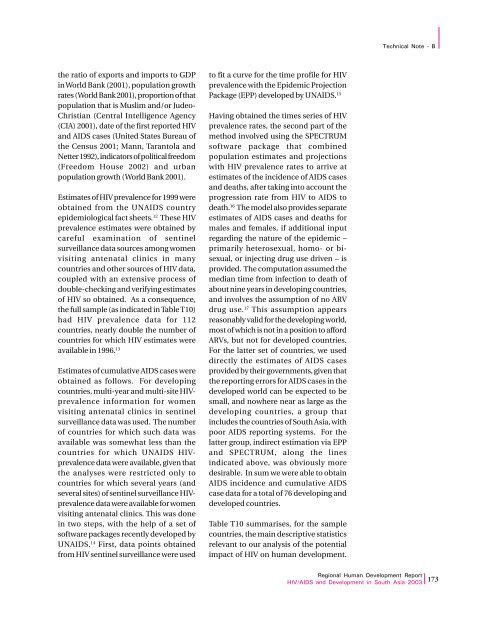Download Report - UNDP Asia-Pacific Regional Centre - United ...
Download Report - UNDP Asia-Pacific Regional Centre - United ...
Download Report - UNDP Asia-Pacific Regional Centre - United ...
Create successful ePaper yourself
Turn your PDF publications into a flip-book with our unique Google optimized e-Paper software.
Technical Note - Bthe ratio of exports and imports to GDPin World Bank (2001), population growthrates (World Bank 2001), proportion of thatpopulation that is Muslim and/or Judeo-Christian (Central Intelligence Agency(CIA) 2001), date of the first reported HIVand AIDS cases (<strong>United</strong> States Bureau ofthe Census 2001; Mann, Tarantola andNetter 1992), indicators of political freedom(Freedom House 2002) and urbanpopulation growth (World Bank 2001).Estimates of HIV prevalence for 1999 wereobtained from the UNAIDS countryepidemiological fact sheets. 12 These HIVprevalence estimates were obtained bycareful examination of sentinelsurveillance data sources among womenvisiting antenatal clinics in manycountries and other sources of HIV data,coupled with an extensive process ofdouble-checking and verifying estimatesof HIV so obtained. As a consequence,the full sample (as indicated in Table T10)had HIV prevalence data for 112countries, nearly double the number ofcountries for which HIV estimates wereavailable in 1996. 13Estimates of cumulative AIDS cases wereobtained as follows. For developingcountries, multi-year and multi-site HIVprevalenceinformation for womenvisiting antenatal clinics in sentinelsurveillance data was used. The numberof countries for which such data wasavailable was somewhat less than thecountries for which UNAIDS HIVprevalencedata were available, given thatthe analyses were restricted only tocountries for which several years (andseveral sites) of sentinel surveillance HIVprevalencedata were available for womenvisiting antenatal clinics. This was donein two steps, with the help of a set ofsoftware packages recently developed byUNAIDS. 14 First, data points obtainedfrom HIV sentinel surveillance were usedto fit a curve for the time profile for HIVprevalence with the Epidemic ProjectionPackage (EPP) developed by UNAIDS. 15Having obtained the times series of HIVprevalence rates, the second part of themethod involved using the SPECTRUMsoftware package that combinedpopulation estimates and projectionswith HIV prevalence rates to arrive atestimates of the incidence of AIDS casesand deaths, after taking into account theprogression rate from HIV to AIDS todeath. 16 The model also provides separateestimates of AIDS cases and deaths formales and females, if additional inputregarding the nature of the epidemic –primarily heterosexual, homo- or bisexual,or injecting drug use driven – isprovided. The computation assumed themedian time from infection to death ofabout nine years in developing countries,and involves the assumption of no ARVdrug use. 17 This assumption appearsreasonably valid for the developing world,most of which is not in a position to affordARVs, but not for developed countries.For the latter set of countries, we useddirectly the estimates of AIDS casesprovided by their governments, given thatthe reporting errors for AIDS cases in thedeveloped world can be expected to besmall, and nowhere near as large as thedeveloping countries, a group thatincludes the countries of South <strong>Asia</strong>, withpoor AIDS reporting systems. For thelatter group, indirect estimation via EPPand SPECTRUM, along the linesindicated above, was obviously moredesirable. In sum we were able to obtainAIDS incidence and cumulative AIDScase data for a total of 76 developing anddeveloped countries.Table T10 summarises, for the samplecountries, the main descriptive statisticsrelevant to our analysis of the potentialimpact of HIV on human development.<strong>Regional</strong> Human Development <strong>Report</strong>HIV/AIDS and Development in South <strong>Asia</strong> 2003 173
















